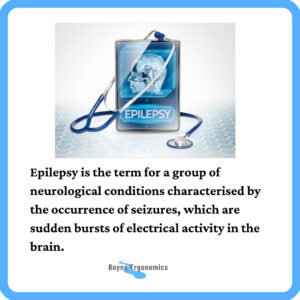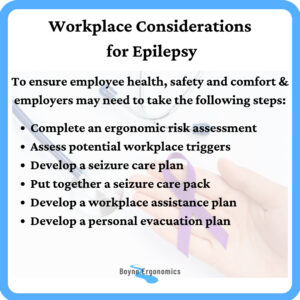Epilepsy is the term for a group of neurological conditions characterised by the occurrence of seizures, which are sudden bursts of electrical activity in the brain. These seizures can range in severity from a person being alert, staring off to the distance, to loss of consciousness and uncontrollable spasms. It is reported that 1 in 5 people will experience a single seizure at some stage of their life. Medications can be used to control the occurrence of seizures, but it can take time to find the right medication and dosage.
In Ireland, there are an estimated 37,000 people over the age of 5 living with epilepsy and it can be diagnosed at any stage of life.

Whether or not a person’s diagnosis of epilepsy impacts their ability to safely carry out their work tasks depends on a range of factors including frequency and triggers of seizures, the type of role and potential safety impact of having a seizure while carrying out their tasks.
In this blog post I am going to outline the basic health, safety and ergonomic considerations for DSE based employees that disclose a diagnosis of epilepsy.
Gain an Understanding of the Diagnosis
Epilepsy is really an umbrella term for a wide range of symptoms and conditions. It is important that both the employee and employer is aware, in as much as they can be, of the types and frequencies of seizures, any known triggers, any warning signs of an impending seizure, any medication required and potential side effects of the medication, any accommodations required and any musculoskeletal issues that may be present.
If the employee is not comfortable discussing this with the employer, or may feel it is not relevant to the role, this should be discussed with the occupational health provider and they can assess what level of disclosure, if any, is required.

Assess Potential Workplace Triggers
Potential triggers that can be present in the workplace include stress, lighting, DSE monitors, temperature, flicker and fatigue.
Being aware of the potential trigger and putting in place accommodations and changes to reduce the occurrence of these factors can help reduce the risk of the employee experiencing a seizure in the workplace.
It is recommended that a review of the employee’s role is completed to ensure that they find the workload manageable, that they are not working alone, they are not working shifts that might negatively impact medication or increase the risk of a seizure, do not drive (if < 1 year without a seizure), they are getting adequate breaks and that there is a trained first aider on site when they are.
Develop a Seizure Care Plan
This plan should cover:
Requirements during and post seizure. This includes estimated time needed to recover, employees preferred recovery location, level of supervision required in recovery, how to identify if emergency care is required and contact person if required.
A suitable area should be identified for recovery, such as a first aid room or rest area.
Put Together a Seizure Care Pack
The employee should be provided with a locker to store items that may be required in the event of a seizure such as the care plan, a breathable pillow, blanket, change of clothes and any medication they may need. A key for this locker should also be given to the nominated first aid person or HR person who can access it for the employee if required.
Request an Ergonomic Risk Assessment
This is to ensure that the employee work area does not present an increased risk of seizure or injury in the event of a seizure.
Factors to consider include posture, the type of computer monitor provided, position of the monitor, presence of glare on the monitor, lighting in the work area, type of seating provided, ability to take breaks from the screen, head injury risks in the area and available free space around the work station.
Employees with epilepsy should be provided with a high quality computer monitor with a refresh rate of at least 60Hz. The monitor should be fitted with an anti glare screen and positioned at least 30cm from their seated position at the desk.
Ensure the workplace is well lit, but avoid fluorescent lighting.
The workstation seating should be a high back chair with armrests, headrest and a braking system.
A wireless headset will allow frequent breaks from the screen when on calls.
Add padding to any hard edges or sharp corners in the work area.
Workplace Assistance
Based on the nature of the employee’s epilepsy condition, it might be valuable to implement a buddy system, or provide the employee with a fall alarm for around their neck to reduce response time in the event of a seizure.
Reduce the need for the employee to use stairs and stairwells.
With their consent, ensure that their immediate colleagues are aware of their condition and steps to take in the event of a seizure.
Accessible Workplace Facilities
Ensure the employee has easy access to an accessible toilet. This is to ensure there is increased space around them, access to an alarm and the door can be opened from the outside in the event of a seizure.
Personal Evacuation Plan
Ensure there is a Personal Evacuation Plan in place for an employee with epilepsy that can be implemented in the event of an emergency.
This should identify their nearest emergency exits, assistance required, mode of reaching the main exit (eg Evac Chair etc) and assistance needed once outside.

Many employees with a diagnosis of epilepsy do not require accommodations in the workplace and can continue to be productive and excel like any other employee. However, implementing these steps above ensures that you as an employer have safeguarded the health and safety of an employee with epilepsy.
Sources:
https://www.epilepsy.ie/content/epilepsy-explained
https://epilepsysociety.org.uk/living-epilepsy/work-employment-and-epilepsy
www.system-concepts.com/insights/epilepsy-workplace-10-step-guide/


